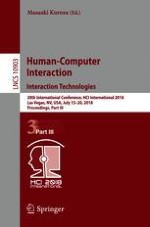2018 | OriginalPaper | Chapter
Character Input by Gesture Performed with Grasping Both Ends of Tablet PC
Authors : Toshimitsu Tanaka, Takuya Mano, Yuuya Tanaka, Kohei Akita, Yuji Sagawa
Published in: Human-Computer Interaction. Interaction Technologies
Publisher: Springer International Publishing
Activate our intelligent search to find suitable subject content or patents.
Select sections of text to find matching patents with Artificial Intelligence. powered by
Select sections of text to find additional relevant content using AI-assisted search. powered by
